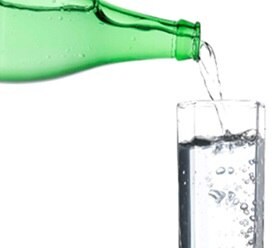Nitrate in Mineral and Drinking Water
Smartphone-based determination of nitrate after reduction to nitrite and reaction with Griess reagent

Introduction
In some regions, nitrate in drinking water is a big problem. By fertilizing the agricultural soils with industrial fertilizers or manure, nitrate enters the groundwater.1
Especially in agricultural areas, drinking water prepared from groundwater can have an increased amount of nitrate. Nitrate itself is not toxic but it can be metabolized in the body to nitrite, which in turn forms cancerogenic nitrosamines. Especially for babies, nitrate can be very dangerous.1
Therefor limits have been introduced to ensure safe drinking water. The limit for nitrate set by the EU directive is 50 mg/L NO3-, while the U.S. EPA specifies 10 mg/L NO3-N.2,3
Check the nitrate content of your water with MQuant® test strips using your smartphone for fast, convenient, and precise results. Test the simplest way to determine nitrate in aqueous solutions. This low-priced and easy-to-use analytical detection system provides reliable quantification of water, food & beverage samples for customers from research, industry, environment and diagnostics.
The following application note describes the determination of nitrate concentrations in drinking water samples using the MQuant® nitrate test strips in combination with the MQuant® StripScan app.
Experimental Method
Nitrate ions are reduced to nitrite ions by a reducing agent. In the presence of an acidic buffer, these nitrite ions react with an aromatic amine to form a diazonium salt, which in turn reacts with N-(1-naphthyl)-ethylene-diamine to form a red-violet azo dye.
Sample Material
Mineral water and drinking water
Measuring Range
0–500 mg/L NO3-
Reagents and Accessories
Raegants
MQuant® Nitrate Test, colorimetric with test strips (1.10020)
Accessories
- MQuant® Card (provided with the test strip box)
- MQuant® StripScan app (can be downloaded via Apple App Store or Google Play Store)
Sample Preparation
The sample can be analysed in its original form.
Sample Analysis
For analysis, follow this procedure:
- Start the app.
- Get your MQuant® test strip and the MQuant® Card ready.
- Dip the test strip into the prepared sample (15 - 25 °C) for approx. 2 seconds, ensuring that the reaction zones are completely immersed.
- Shake off excess liquid from the strip and dry the backside of the strip using a paper towel.
- Select the parameter NO3- (1.10020) in the app. A 60 second countdown is displayed on the screen, which begins immediately after selecting the parameter NO3-.
- Just before the end of the countdown, place the test strip on the MQuant® Card.
- After the waiting time is elapsed, place the MQuant® Card with the test strip within the viewfinder on your phone screen, and align the camera along the reference points.
- The picture is captured automatically by the camera of the smartphone.
- The result is displayed on the screen in mg/L NO3-.
Results
Comparison with Reflectoquant® Nitrate Test and Spectroquant® Nitrate Test
The results were verified by performing a reference analysis with the Reflectoquant® Test (1.16995) and Spectroquant® Test (1.09713). The measurement with the Reflectoquant® Test and Spectroquant® Test were performed according to the corresponding package insert.
In addition, spiking experiments were performed. For this purpose, the samples were spiked with 25 mg/L NO3-. Afterwards, the recovery rate (RR) was calculated based on the recovered content.
The results are shown in the following table.
Spiking |
|---|
Conclusion
The MQuant® Nitrate test in combination with the MQuant® StripScan app is a quick and easy way to analyze the nitrate concentration in drinking and mineral water. The spiking experiments showed a good recovery rate: The values are comparable to those measured with the Reflectoquant® test and the photometric Spectroquant® test for nitrate.
As always (whenever trying a new method of analysis) it is recommended to do plausibility checks and to compare the results with a reference method.
For More Information
References
To continue reading please sign in or create an account.
Don't Have An Account?